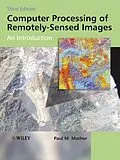Remotely-sensed images of the Earth's surface provide a valuablesource of information about the geographical distribution andproperties of natural and cultural features. This fully revised andupdated edition of a highly regarded textbook deals with themechanics of processing remotely-senses images. Presented in anaccessible manner, the book covers a wide range of image processingand pattern recognition techniques. Features include: * New topics on LiDAR data processing, SAR interferometry, theanalysis of imaging spectrometer image sets and the use of thewavelet transform. * An accompanying CD-ROM with: * updated MIPS software, including modules for standardprocedures such as image display, filtering, image transforms,graph plotting, import of data from a range of sensors. * A set of exercises, including data sets, illustrating theapplication of discussed methods using the MIPS software. * An extensive list of WWW resources including colourillustrations for easy download. For further information, including exercises and latest softwareinformation visit the Author's Website at:http://homepage.ntlworld.com/paul.mather/ComputerProcessing3/
Autorentext
Paul Mather has been Professor of Geographical Information Science at The University of Nottingham, UK since 1988. BA (Cambridge), PhD (Nottingham). Main research interests: multivariate analysis of spatial data (Computational Methods of Multivariate Analysis in Physical Geography, Chichester, John Wiley, 1976) and digital image processing applied to remotely sensed data, particularly algorithms for classification and pattern recognition (Classification Methods for Remotely Sensed Data, with B. Tso, London, Taylor and Francis, 2001).
- Awarded OBE in the Queen's Jubilee Honours in 2002 for 'services to remote sensing and photogrammetry'.
- Recipient of The Remote Sensing Society's Gold Medal in 1996.
- Presented with the Back Award of the Royal Geographical Society for 'contributions to remote sensing' in 1992.
- Winner of the Dearing Award for "Outstanding contribution to the development of teaching and learning", The University of Nottingham, 2003.
- Invited speaker/lecturer at conferences/courses all over the world (e.g., Japan, Indonesia, India, South Africa, Poland, Hungary, Bulgaria, Spain).
Zusammenfassung
Remotely-sensed images of the Earth's surface provide a valuable source of information about the geographical distribution and properties of natural and cultural features. This fully revised and updated edition of a highly regarded textbook deals with the mechanics of processing remotely-senses images. Presented in an accessible manner, the book covers a wide range of image processing and pattern recognition techniques. Features include:
- New topics on LiDAR data processing, SAR interferometry, the analysis of imaging spectrometer image sets and the use of the wavelet transform.
- An accompanying CD-ROM with:
- updated MIPS software, including modules for standard procedures such as image display, filtering, image transforms, graph plotting, import of data from a range of sensors.
- A set of exercises, including data sets, illustrating the application of discussed methods using the MIPS software.
- An extensive list of WWW resources including colour illustrations for easy download.
For further information, including exercises and latest software information visit the Author's Website at: http://homepage.ntlworld.com/paul.mather/ComputerProcessing3/
Inhalt
Preface to the First Edition.
Preface to the Second Edition .
Preface to the Third Edition.
List of Examples.
1. Remote Sensing: Basic Principles.
1.1 Introduction.
1.2 Electromagnetic radiation and its properties.
1.2.1 Terminology.
1.2.2 Nature of electromagnetic radiation.
1.2.3 The electromagnetic spectrum.
1.2.4 Sources of electromagnetic radiation.
1.2.5 Interactions with the Earth's atmosphere.
1.3 Interaction with Earth-surface materials.
1.3.1 Introduction.
1.3.2 Spectral reflectance of Earth surface materials.
1.3.2.1 Vegetation.
1.3.2.2 Geology.
1.3.2.3 Water bodies.
1.3.2.4 Soils.
1.4 Summary.
2. Remote Sensing Platforms and Sensors.
2.1 Introduction.
2.2 Characteristics of imaging remote sensing instruments.
2.2.1 Spatial resolution.
2.2.2 Spectral resolution.
2.2.3 Radiometric resolution.
2.3 Optical, near-infrared and thermal imaging sensors.
2.3.1 Along-Track Scanning Radiometer (ATSR).
2.3.2 Advanced Very High Resolution Radiometer (AVHRR).
2.3.3 MODIS (MODerate Resolution Imaging Spectrometer).
2.3.4 Ocean observing instruments.
2.3.5 IRS-1 LISS.
2.3.6 Landsat Instruments.
2.3.6.1 Landsat Multi-spectral Scanner (MSS).
2.3.6.2 Landsat Thematic Mapper (TM).
2.3.6.3 Enhanced Thematic Mapper Plus (ETM+).
2.3.6.4 Landsat follow-on programme.
2.3.7 SPOT sensors.
2.3.7.1 SPOT High Resolution Visible (HRV).
2.3.7.2 Vegetation (VGT).
2.3.7.3 SPOT follow-on programme.
2.3.8 Advanced Spaceborne Thermal Emission and Reflection Radiometer (ASTER).
2.3.9 High-resolution commercial and micro-satellite systems.
2.3.9.1 High-resolution commercial satellites - IKONOS.
2.3.9.2 High-resolution commercial satellites - QuickBird.
2.4 Microwave imaging sensors.
2.4.1 ERS SAR.
2.4.2 RADARSAT.
2.5 Summary.
3. Hardware and Software Aspects of Digital Image Processing.
3.1 Introduction.
3.2 Properties of digital remote sensing data.
3.2.1 Digital data.
3.2.2 Data formats.
3.2.3 System processing.
3.3 MIPS software.
3.3.1 Installing MIPS.
3.3.2 Using MIPS.
3.3.3 Summary of MIPS functions.
3.4 Summary.
4. Pre-processing of Remotely Sensed Data.
4.1 Introduction.
4.2 Cosmetic operations.
4.2.1 Missing scan lines.
4.2.2 De-striping methods.
4.2.2.1 Linear method.
4.2.2.2 Histogram matching.
4.2.2.3 Other destriping methods.
4.3 Geometric correction and registration.
4.3.1 Orbital geometry model.
4.3.2 Transformation based on ground control points.
4.3.3 Resampling procedures.
4.3.4 Image registration.
4.3.5 Other geometric correction methods.
4.4 Atmospheric correction.
4.4.1 Background.
4.4.2 Image-based methods.
4.4.3 Radiative transfer models.
4.4.4 Empirical line method.
4.5 Illumination and view angle effects.
4.6 Sensor calibration.
4.7 Terrain effects.
4.8 Summary.
5. Image Enhancement Techniques.
5.1 Introduction.
5.2 Human visual system.
5.3 Contrast enhancement.
5.3.1 Linear contrast stretch.
5.3.2 Histogram equalisation.
5.3.3 Gaussian Stretch.
5.4 Pseudocolour enghancement.
5.4.1 Density slicing.
5.4.2 Pseudocolour transform.
5.5 Summary.
6. Image Transforms.
6.1 Introduction.
6.2 Arithmetic operations.
6.2.1 Image addition.
6.2.2 Image subtraction.
6.2.3 Image multiplication.
6.2.4 Image division and vegetation ratios.
6.3 Empirically based image transforms.
6.3.1 Perpendicular Vegetation Index.
6.3.2 Tasselled Cap (Kauth-Thomas) transformation.
6.4 Principal Components Analysis.
6.4.1 Standard Principal Components Analysis.
6.4.2 Noise-adjusted Principal Components Analysis.
6.4.3 Decorrelation stretch.
6.5 Hue, Saturation and Intensity (HIS) transform.
6.6 The Discrete Fourier Transform.
6.6.1 Introducti…
